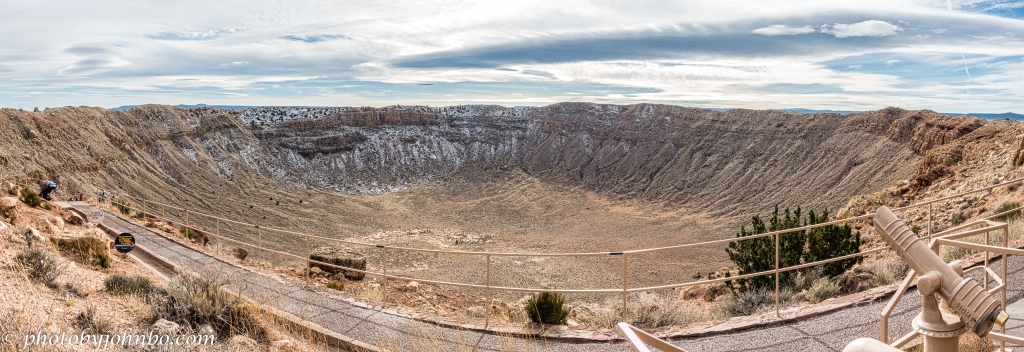
Winslow, Arizona.
Since 2011, we’ve driven I-40 in northern Arizona twice a year on our way two and from Buckeye, Arizona. Every time we passed by exit 233, the Meteor Crater exit, we were in too big a hurry to stop and we drove on by. That is, until 2020. We drove the 6 miles (10 km) to the Barringer Space Museum and Meteor Crater complex only to find it closed because of the Pandemic.
Last December, on our way to visit my sister in Albuquerque for Christmas, we tried again to stop at the complex. This time, we were successful. Upon our arrival, I came to the immediate conclusion that we should have stopped years ago. The museum, which is privately owned, is well presented, and visitors can opt for a guided or self-guided tour.
50,000 years ago, an iron-nickel meteorite some 150 feet (45 m) across, and weighing many hundred thousand tons slammed into the Arizona desert at about 26,000 miles per hour (41,850 km/hour). The meteor was basically obliterated into small pieces with bits scattering around the area.
Pieces of meteor of any size have long ago been “harvested” for research or display. The crater that was left is over 700 feet (213 m) deep and over 4,000 feet (1219 m) across. Some fragments of debris, both meteorite and desert landscape were thrown over a mile. Some fragments were found several miles away.
One worthy stop in the museum is at the theater to view Collision! 4D, a virtual journey into space. For a more educational program, check out Impact! Theater where the history and geology of the crater are presented through the work of Daniel M. Barringer.
One of the larger museum exhibits rests outside the building. It’s a test capsule from the Apollo moon mission. The capsule never went into space but was used in preparing astronauts for the moon missions. Astronauts trained at Meteor Crater because of its similarity to craters on the moon.
One of the platforms for viewing the crater contains several telescopes fixed on specific research items on the crater floor. In the image above, some visitors are checking out the telescopic view.
I was surprised to discover that I could put my camera lens in front of the telescope and capture the image therein. This telescope was labeled “Main Shaft”. I did have to experiment with camera distance from the telescope and kept trying until I got a decent image. I then found it easy to enhance using my usual photo processing tools.
Equipment found on the crater floor included this boiler and winch. They are barely visible when looking from the wide-angle images I captured, but the telescope brings them up close.
The sand and rock that were thrown up from the strike are found even near the top of the rim, as you can see by the image above. On the day we visited, we were treated to a bit of snow remaining on the shaded south rim from a recent snowfall. It added to the beauty of the crater.
Near the Apollo capsule, a large “picture window” (without glass) looks toward Flagstaff and the San Fransisco Peaks, and Arizona’s highest point, Humphrey’s Peak at 12,633 feet (3,850 m).
People who choose a self-guided tour can find plenty of railed walkways that lead to the fenced observation platforms. The levels are many, so you can expect to do some uphill and downhill walking as you investigate the crater.
Visitors can purchase tickets online for a range of $15 to $24 per person. Active Duty U.S. Military members are free. The tickets are not dated, so they are usable anytime the facility is open. All activities are included with the price of the ticket. The guided tour is 45-50 minutes in length.
You can click on any of the images above to view the image in 2K HD or visit my Flickr album here. I have a more complete gallery of images there with additional photos of the museum and the crater itself. Meteor Crater is a worthy stop. You can expect to spend 2-3 hours there, more if you take the guided tour.
John Steiner




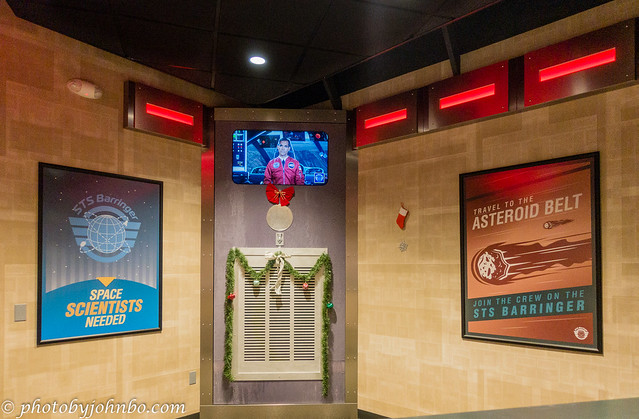
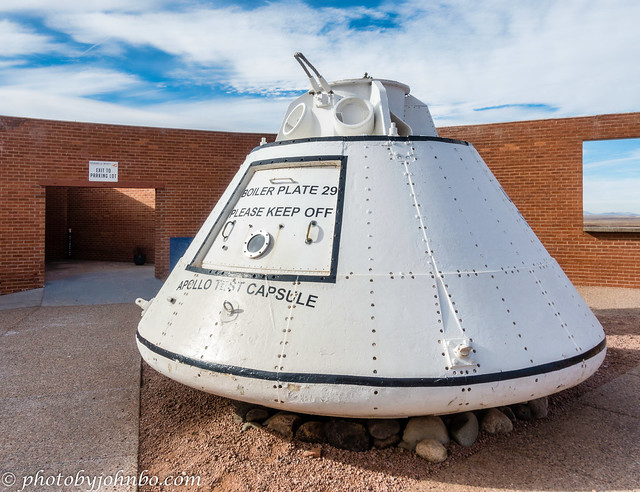
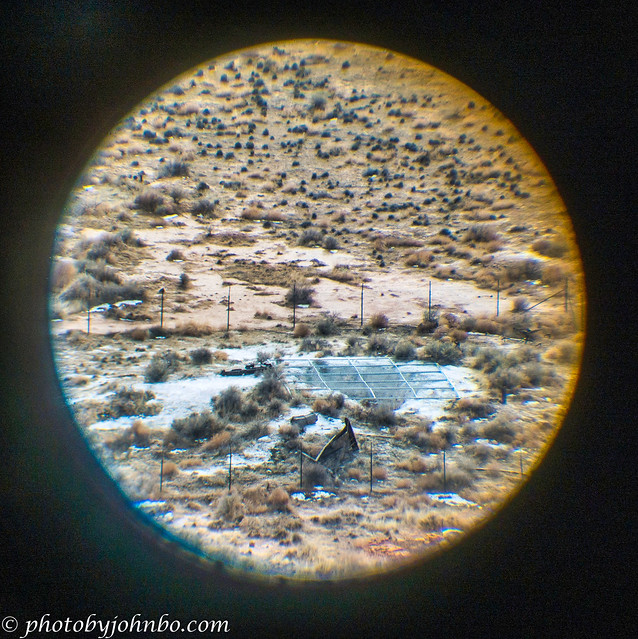
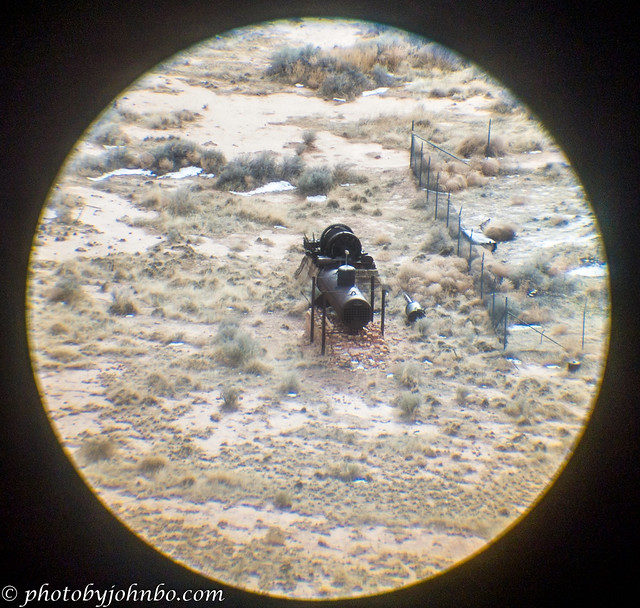


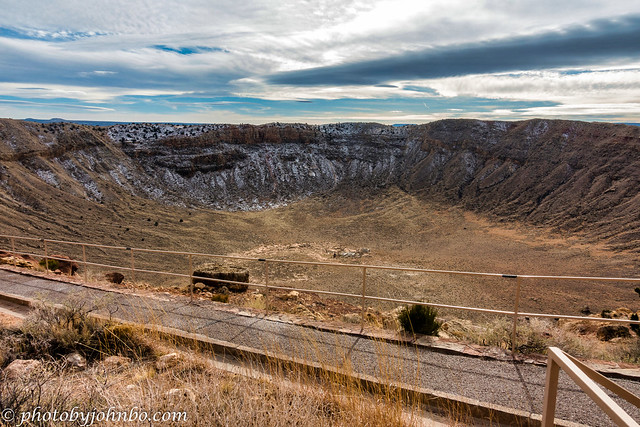
The crater is impressive compared to the size of the meteorite; it’s neat to be able to see the result of this ancient phenomenon and to have all the explanations that go with it!
I can’t imagine the destruction if something like this hit a populated area these days.
Looks like a massive crater.
Can these craters be used to store drinking water?
Lovely captures.
Clicking photos through telescope is interesting.
Thank you for taking us to this part of the world and explaining things in detail.
Thanks, Philo. I’m sure that this crater could hold water, though some openings have been dug in the bottom in the last couple of centuries.
The problem would be getting water to the site. It is a long way from any natural water sources.
I was also wondering about heavy rainfall on a regular basis filling the crater at least 25% of its capacity
Thank you John.
Nearby Winslow Arizona gets less than 20 cm of rain annually. It’s one of the driest areas in the state.
So No chance at all…
It would have been more useful if the meteor had struck further west near what is now Flagstaff. They have a fair amount of snow runoff each spring. It would have made for a natural lake.
Wow this is amazing!
It is indeed! Well worth the stop if you are anywhere nearby.
I remember visiting and being awed by this crater when we were in Arizona in the mid 1990s but it seems there is far more to the museum these days, It does make you wonder what would happen if a similarly sized meteorite were to head our way today!
On taking photos through the telescope, one of our guides in Costa Rica showed us how you can often get the best results using a phone camera, because its lens is smaller than the diameter of the telescope lens. He took some photos of sloths and toucans with my phone to demonstrate. If you are curious you can see how well they came out towards the end of this post: https://www.toonsarah-travels.blog/the-oddities-of-sloths/
That’s a cool tip, Sarah. I used my D500 Nikon with a much bigger lens. I’ll have to remember that tip. Nice images on your link proving the point.
Thanks for the tour and sharing the info. The largest fragment, fascinating!
Indeed. For something so large, it sure broke up into relatively small pieces.
A museum as well as a whole crater, definitely what I want to experience. I’m so glad to read this space-themed content and discover another place to add to my (probably too) long dream destination list. Apart from the crater, the “window” view looks great. You visited on a wonderful day.
It is a worthwhile stop on a long drive across the desert.
It must have been amazing to see this massive crater John!
It was indeed. I can’t imagine the impact that must have been felt in the area.
An absolutely enormous impact
What an incredible place to visit!
It is, indeed. It is so much more than a dent in the earth. >grin<
Thank you for this post! I’ve added this meteor crater to my list…
It is a worthwhile stop that is not far out of the way if you are headed on I-40 between New Mexico and points west.